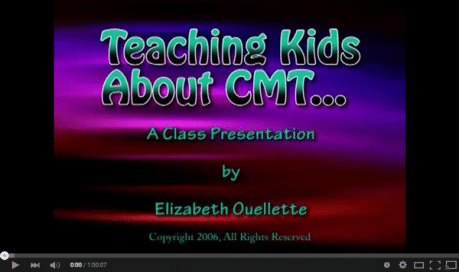Why does Yohan have funny shoes? Why can’t he run fast and climb trees? And how come he gets tired so easily? These are just some of the questions friends and classmates have asked about my 11-year-old son over the years. They realize that Yohan has some differences, but they don’t quite know what to make of them!
After giving it some thought, I decided to present CMT to the entire class in a very upbeat, interactive, and educational way. My goal was to have the students actually acquire some sense of what it might be like to have CMT. I wanted them to empathize with Yohan, understand him, and accept him—not feel sorry for him.
 I spent several minutes explaining the meaning and origin of CMT, and then I involved the class in a discussion and some activities. First we talked about the peripheral nervous system, and the difference between sensory and motor nerves. Then I explained that kids with CMT may have problems with tasks requiring fine motor skills. To demonstrate how difficult it can be for someone like Yohan to perform everyday activities, I gave each student a button-down shirt and a pair of socks. I had them put a sock on each hand, and then I asked them to button their shirts up as fast as possible. I heard, “This is hard,” “I can’t do this,” and even, “I give up!” This exercise led to a wonderful discussion about how the frustrations of writing, tying shoelaces, and buttoning shirts, presented ongoing, daily challenges for people with CMT.
I spent several minutes explaining the meaning and origin of CMT, and then I involved the class in a discussion and some activities. First we talked about the peripheral nervous system, and the difference between sensory and motor nerves. Then I explained that kids with CMT may have problems with tasks requiring fine motor skills. To demonstrate how difficult it can be for someone like Yohan to perform everyday activities, I gave each student a button-down shirt and a pair of socks. I had them put a sock on each hand, and then I asked them to button their shirts up as fast as possible. I heard, “This is hard,” “I can’t do this,” and even, “I give up!” This exercise led to a wonderful discussion about how the frustrations of writing, tying shoelaces, and buttoning shirts, presented ongoing, daily challenges for people with CMT.
Next, I brought in a model of a 10-foot-long myelin sheath in which nerves stuck out on both sides. (I made this with a black hose, through which I threaded many different-colored wires). I showed how the myelin sheath protects the nerves and, in turn, helps them conduct impulses to and from the brain. Delicately, avoiding negative terms like “damaged” or “abnormal,” I explained that the myelin sheath in people with CMT is “thinner” and thus less apt to protect and conduct as rapidly or as efficiently as the myelin sheath of someone who does not have a neuromuscular disease.
To illustrate how the loss of myelin affects nerves, I chose three volunteers and asked them to first run the length of the sheath four times and then hop the same distance. They all agreed that hopping was much harder and time-consuming. This activity ultimately gave them insight into why muscles in CMT get tired quickly and just how much more energy a person with CMT must expend to perform the same tasks as everyone else.
Finally, I divided the class into groups of four or five students. Each group (except my son’s group) was given a full bottle of glue. His group also received a glue bottle, but, they didn’t know it was filled with water. I declared that the first group to squeeze out all the glue from the bottle would be the winner. On “Go,” they all squeezed furiously, wanting to win the bags of candy I held out as the prize.
Of course, the group with water in their bottle won very quickly. Cries of unfairness and injustice rang loudly throughout the room, especially when I handed out the bags of candy to only five members of a class of 21. When one child blurted out, “Oh… I get it, we all have CMT and despite all our efforts, the non-CMT group won the prize,” the others reflected on what was just said and I saw light bulbs illuminating the entire room!
This exercise produced much empathy and insight, which in turn produced a deeper acceptance of my son and a more profound understanding of CMT. Finally, I reminded the class that everyone has some condition or obstacle to overcome, whether it’s wearing glasses or braces or something else. I left them with the following thought: if we all tried to be open to the differences of others and learn to accept them without judgment, this would be a much better world!





